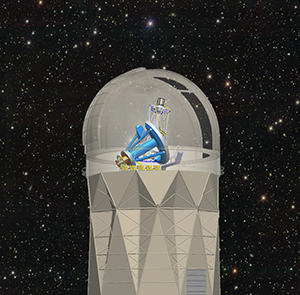Dark Energy Spectroscopic Instrument Receives Next Step of Approval from DOE
Carnegie Mellon’s Shirley Ho Co-Chairs Working Group for Upcoming Major Sky Survey, Which Will Improve Understanding of the Universe

PITTSBURGH— The Dark Energy Spectroscopic Instrument (DESI) has reached its next major milestone. The project has received Critical Decision-2 approval from the U.S. Department of Energy (DOE). This approval authorizes the project’s scientific scope, schedule and funding profile, ensuring that the project will be supported into the next decade.
Shirley Ho, a member of Carnegie Mellon University’s McWilliams Center for Cosmology, is the co-chair of DESI’s Galaxy and Quasar Clustering Working Group. The working group will produce the flagship science results for DESI’s probes of dark energy and gravity.
When complete, DESI will provide valuable information about how dark energy and gravity have created structure in the universe, and about the universe’s expansion history. Ever since scientists discovered that the universe was expanding at an accelerated rate, they have been looking to understand the reasons for this acceleration, which aren’t explained by Einstein’s theory of gravity.
“DESI will push science further than we have ever gone before,” said Ho, the Cooper-Siegel Assistant Professor of Physics in Carnegie Mellon’s Mellon College of Science. “DESI will push science further than we have ever gone before. We will get a map of the universe from when the universe was very young, about one-seventh of its current age. This will help us to better understand dark matter, dark energy and other mysterious things in our universe.”
DESI is a state-of-the-art spectrometer that will be mounted on top of the National Optical Astronomy Observatory-operated Mayall Telescope located near Tucson, Arizona. To accommodate DESI, the telescope has been retrofitted with new glass lenses that will focus light onto DESI’s focal plane. The focal plane will have 5,000 small robotic arms, each of which holds an optical fiber. Once the telescope and spectrometer are operational, the robotic arms will position the fibers to capture light from a single galaxy or quasar at a time. In all, the spectrometer will capture the spectra of a more than 30 million galaxies and quasars. At the end of the project, researchers will be able to measure the spectra of 10 times as many galaxies as DESI’s predecessor, the Baryon Oscillation Spectroscopic Survey of the Sloan Digital Sky Survey.
From these data, they will be able to create the largest three-dimensional map of the universe yet -- one that reaches earlier in the universe’s history than ever before. The map will show how galaxies and other matter cluster together. The map also can be used to visualize fluctuations of density in the early universe called baryon acoustic oscillations (BAOs), which act as a standard ruler to measure the effect dark energy has on the universe’s expansion.
Beyond BAOs, DESI will be used to weigh the total mass of neutrinos in the universe, providing insight into the standard model of particle physics. It also will provide data that can be used to test the theory of General Relativity, Einstein’s theory of gravity, and models for the expansion of the universe.
Two hundred physicists and astronomers from institutions around the world will participate in DESI.
The DESI Project is funded by the U.S. Department of Energy, Office of Science; additional support has been provided by the U.S. National Science Foundation, the Gordon and Betty Moore Foundation, the Heising-Simons Foundation, the Science and Technologies Facilities Council of the United Kingdom, the Consejo Nacional de Ciencia y Tecnología, Mexico, the Chinese Academy of Sciences, and the DESI Membership from: Aix-Marseille University; Argonne National Laboratory; Barcelona-Madrid Regional Participation Group; Brookhaven National Laboratory; Boston University; Carnegie Mellon University; CEA-IRFU, Saclay; China Participation Group; Cornell University; Durham University; École Polytechnique Fédérale de Lausanne; Eidgenössische Technische Hochschule, Zürich; Fermi National Accelerator Laboratory; Granada-Madrid-Tenerife Regional Participation Group; Harvard University; Korea Astronomy and Space Science Institute; Korea Institute for Advanced Study; Institute of Cosmological Sciences, University of Barcelona; Lawrence Berkeley National Laboratory; Laboratoire de Physique Nucléaire et de Hautes Energies; Mexico Regional Participation Group; National Optical Astronomy Observatory; Siena College; SLAC National Accelerator Laboratory; Southern Methodist University; Swinburne University; The Ohio State University; Universidad de los Andes; University of Arizona; University of California, Berkeley; University of California, Irvine; University of California, Santa Cruz; University College London; University of Michigan at Ann Arbor; University of Pennsylvania; University of Pittsburgh; University of Portsmouth; University of Queensland; University of Toronto; University of Utah; UK Regional Participation Group; Yale University. For more information, visit desi.lbl.gov.
###
Image caption and credit: The Dark Energy Spectroscopic Instrument (DESI) will be mounted on the 4-Meter Mayall telescope at Kitt Peak National Observatory. It will collect spectra from 30 million galaxies and quasars to make the biggest 3D map of the universe ever. (R. Lafever and J. Moustakas for the DESI Collaboration, background image by Dark Energy Camera Legacy Survey.)
